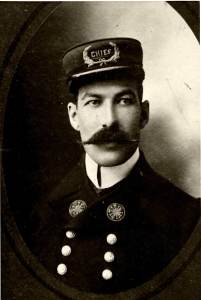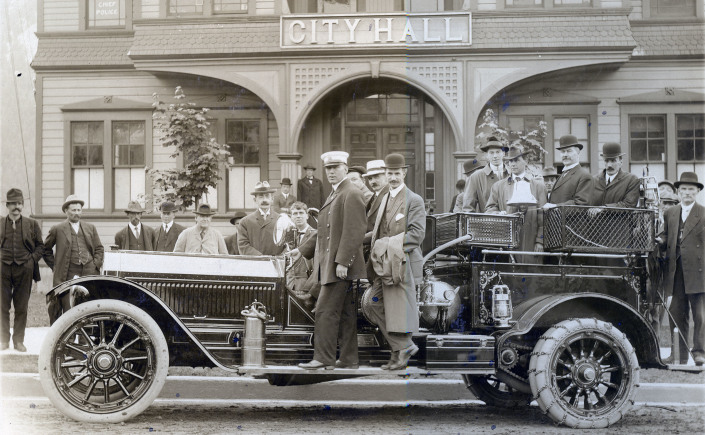The following was first published in Route 3, Summer 2014.
Hail to the (fire) chief
Donald Guthrie left his mark as a firefighter on Nelson and Rossland
By Greg Nesteroff
Donald Guthrie’s name isn’t well known today in Rossland or Nelson, but it should be. As fire chief in both cities, he was at the helm during several major crises and convinced the powers that be to build new halls and buy motorized equipment.
Guthrie spent 13 years as a firefighter in his native Montreal, where he rose to the rank of captain. In 1899, at age 35, he was chosen from among 40 applicants to become Rossland’s chief after a previous man quit in a dispute with city council. According to Rosa Jordan and Derek Choukalos in Rossland: The First 100 Years, Guthrie’s leadership “greatly improved the skill and morale of Rossland’s volunteer firefighters,” and soon the brigade was winning competitions. That same year, Guthrie was “considered most favorably” among shortlisted candidates to become fire chief of Toronto. He and his fiancee also married following a six-year engagement.
 Early in 1900, Rossland completed a magnificent brick fire hall on First Ave. and Queen St. with three large arched bays, stables, and upper floor living quarters. The building later doubled as city hall. There Guthrie led a force that included an assistant chief, two drivers, and four firefighters.
Early in 1900, Rossland completed a magnificent brick fire hall on First Ave. and Queen St. with three large arched bays, stables, and upper floor living quarters. The building later doubled as city hall. There Guthrie led a force that included an assistant chief, two drivers, and four firefighters.
In August 1902, fire destroyed the business section on both sides of Spokane St. between Columbia Ave. and First Ave., plus a number of homes. There was only one injury: Guthrie himself, who led his men inside the burning Burns block, and then jumped from a second-story window.
The Rossland Miner reported that Guthrie hit some wires on the way down and was knocked out, but “soon recovered his senses and once more assumed charge of the battle, with a badly marked face.”
In 1906, the city laid Guthrie off to cut costs. It’s unclear what he did for the next two years, but in late 1908 he was hired as chief in Nelson. However, he found the city’s fire hall at the corner of Victoria and Josephine “poorly located, unsanitary, and dilapidated,” and called for a replacement. It fell on deaf ears and Guthrie soon applied to become chief in Victoria — but his application was rejected because he wanted too much money.
Guthrie’s darkest hour came when Nelson’s mayor suspended him, alleging that after being “absent from duty three or four days, hopelessly intoxicated” he had again fallen off the wagon. City council, however, reinstated him and he then made life difficult for the assistant chief and firefighter who reported his conduct. The mayor concluded Guthrie was exacting revenge and asked that council dismiss him — but they refused, so he remained on the job while the assistant chief quit instead. Council decided to post the job and let Guthrie apply, but rather than let his pride be wounded further, he quit. It was only after receiving a 350-name petition in support of the beleaguered chief that council relented and Guthrie agreed to stay.
In the summer of 1911, Nelson’s fire brigade was kept busy almost nightly as a fire bug targeted lumber yards, brothels, Chinatown, and even a tool shed next to the fire hall. The attacks peaked in September when the brewery and idle smelter burned on consecutive nights. A suspect was arrested and tried several times before finally being convicted of lighting a single fire. No doubt all this helped Guthrie convince council of the merits of a new hall. They wanted to put it on the same site as the existing building, but Guthrie insisted the corner of Ward and Latimer streets was the ideal location as it provided better access to the upper city. He won that argument and the fire department’s new brick home opened there in May 1913.
Although designed for horses, within a year Guthrie further persuaded council the future of firefighting lay in automobiles. The department took possession of its first engine in July 1914 and for the next decade, animals and machines worked side-by-side.
In April 1921, Nelsonites were shocked by the headline “Chief Guthrie fails to rally.” “Nelson lost one of its most popular and respected civic employees and one of its most generous workers in patriotic and benevolent activities yesterday,” the story read. Guthrie suffered a brain abscess and couldn’t be saved despite an operation and “all the attention of doctors and special nurses.” He was 57. On the day of the funeral, stores and offices closed and flags flew at half mast. The procession to the Nelson cemetery stretched several blocks. The entire fire department accompanied the casket, which lay on a hose wagon under a huge mound of flowers.
Guthrie’s legacies are the two fire halls built under his watch, although Rossland’s is no longer used for that purpose (it’s since been a museum, wine bar, coffee company, and condominium). But Nelson’s hall celebrated its centennial last year and is indisputably the oldest in BC still in use. Guthrie’s portrait hangs on an upper floor.
Photos for this article are courtesy of Touchstones and the Rossland Museum & Discovery Centre.
